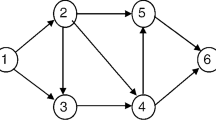Abstract
This paper is concentrated on two types of fuzzy linear programming problems. First type with fuzzy coefficients in the objective function and the second type with fuzzy right-hand side values and fuzzy variables. Considering fuzzy derivative and fuzzy differential equations, these kinds of problems are solved using a fuzzy neural network model. To show the applicability of the method, it is applied to solve the fuzzy shortest path problem and the fuzzy maximum flow problem. Numerical results illustrate the method accuracy and it’s simple implementation.




Similar content being viewed by others
References
Bellman RE, Zadeh LA (1970) Decision-making in a fuzzy environment. Manage Sci 17:141–161
Zimmerman HJ (1983) Fuzzy mathematical programming. Comput Ops Res 10(4):291–298
Negoita CV (1970) Fuzziness in management. OPSA/TIMS, Miami
Dubois D, Prade H (1982) System of linear fuzzy constraints. Fuzzy Sets Syst 13:1–10
Tanaka H, Asai K (1984) Fuzzy linear programming with fuzzy numbers. Fuzzy Sets Syst 13:1–10
Shaocheng T (1994) Interval number and fuzzy number linear programming. Fuzzy Sets Syst 66:301–306
Ebrahimnejad A, Nasseri SH, Hosseinzadeh Lotfi F, Soltanifar M (2010) A primal-dual method for linear programming problems with fuzzy variables. Eur J Ind Eng 4:189–209
Ganesan K, Veeramani P (2006) Fuzzy linear programs with trapezoidal fuzzy numbers. Ann Oper Res 143:305–315
Ebrahimnejad A, Nasseri SH, Hosseinzadeh Lotfi F (2010) Bounded linear programs with trapezoidal fuzzy numbers. Int J Uncertain Fuzziness Knowl Based Syst 18:269–286
Effati S, Nazemi AR (2006) Neural networks models and its application for solving linear and quadratic programming problems. Appl Math Comput 172:305–331
Bazaraa MS, Jarvis John J, Sherali HD (1992) Linear programming and network flows. Wiley, New York
Dantzig GB, Thapa MN (1997) Linear programming. Springer, New York
Moazeni S (2006) Fuzzy shortest path problem with finite fuzzy quantities. Appl Math Comput 183:160–169
Okada A (2004) Fuzzy shortest path problems incorporating interactivity among paths. Fuzzy Sets Syst 142:335–357
Okada S, Soper T (2000) A shortest path problem on a network with fuzzy arc lengths. Fuzzy Sets Syst 109:129–140
Chuang TN, Kung JY (2006) A new algorithm for the discrete fuzzy shortest path problem in a network. Appl Math Comput 174:660–668
Chuang TN, Kung JY (2005) The fuzzy shortest path length and the corresponding shortest path in a network. Comput Oper Res 32:1409–1428
Hernandesa F, Lamatab MT, Verdegayb JL, Yamakamic AK (2007) The shortest path problem on networks with fuzzy parameters. Fuzzy Sets Syst 158:1561–1570
Ji X, Iwamura K, Shao Z (2007) New models for shortest path problem with fuzzy arc lengths. Appl Math Model 31:259–269
Boulmakoul A (2004) Generalized path-finding algorithms on semirings and the fuzzy shortest path problem. J Comput Appl Math 162:263–272
Keshavarza E, Khorram E (2009) A fuzzy shortest path with the highest reliability. J Comput Appl Math 230:204–212
Effati S, Jafarzadeh M (2007) Nonlinear neural networks for solving the shortest path problems. Appl Math Comput 189:567–574
Yinzhen L, Mitsuo G, Kenichi I (1996) Solving fuzzy shortest path problems by neural network. Comput Eng 31:861–865
Lopez RR (2008) Periodic boundary value problems for impulsive fuzzy differential equations. Fuzzy Sets Syst 159:1384–1409
Lupulescu V (2009) On a class of fuzzy functional differential equations. Fuzzy Sets Syst 160:1547–15625
Puri ML, Ralescu D (1986) Fuzzy random variables. J Math Anal Appl 114:409–422
Panigrahi M, Panda G, Nanda S (2008) Convex fuzzy mapping with differentiability and its application in fuzzy optimization. Eur J Oper Res 185(1):47–62
Stefanini L, Sorini L, Guerra ML (2006) Parametric representation of fuzzy numbers and application to fuzzy calculus. Fuzzy Sets Syst 157:2423–2455
Pederson S, Sambandham M (2009) Numerical solution of hybrid fuzzy differential equation IVPs by a characterization theorem. Inf Sci 179:319–328
Chalco-Cano Y, Roman-Flores H (2008) On new solutions of fuzzy differential equations. Chaos Solitons Fractals 38(1):112–119
Author information
Authors and Affiliations
Corresponding author
Rights and permissions
About this article
Cite this article
Effati, S., Pakdaman, M. & Ranjbar, M. A new fuzzy neural network model for solving fuzzy linear programming problems and its applications. Neural Comput & Applic 20, 1285–1294 (2011). https://doi.org/10.1007/s00521-010-0491-4
Received:
Accepted:
Published:
Issue Date:
DOI: https://doi.org/10.1007/s00521-010-0491-4




